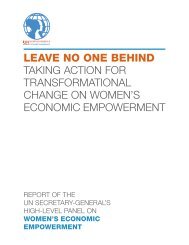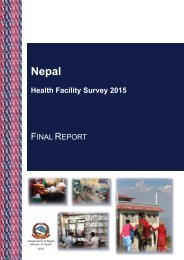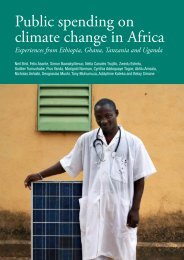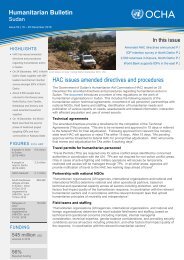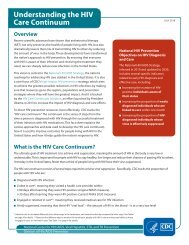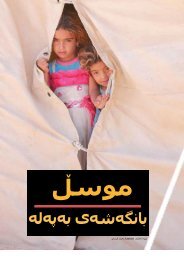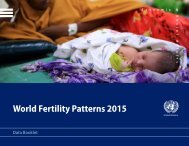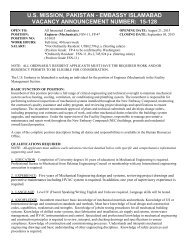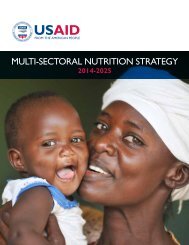IOM Sierra Leone
REsG0
REsG0
- No tags were found...
Create successful ePaper yourself
Turn your PDF publications into a flip-book with our unique Google optimized e-Paper software.
<strong>IOM</strong> Kambia field monitors continue their work<br />
On 26 August 2015, Zainab Kamara and her interim care<br />
kit colleagues were engaged in the urgent distribution of<br />
kits in the communities of Debia, Rokupr, Bamoi Luma,<br />
Magbety and households in Kambia town. Interim Care<br />
Kits (ICKs) are prepositioned in 880 communities in Kambia<br />
with 822 Community Health Monitors (CHMs) under the<br />
supervision of 5 <strong>IOM</strong> Field Monitors and 13 Community<br />
Surveillance Supervisors (CSS). Kits are stored at Peripheral<br />
Health Units in all seven chiefdoms of Kambia district.<br />
A recent case in Kambia on Sunday and intensive cross<br />
border movement from neighbouring Guinea demonstrates<br />
the potential positive impact of pre-positioned care<br />
kits in the area should further cases be reported. Many<br />
areas of Kambia are difficult to reach by road during the<br />
rainy season and response time by medical teams can be<br />
severely affected.<br />
Mohamed Turay, is one of <strong>IOM</strong>’s Field Monitors engaged<br />
in community supervision in Koya village, Samu Chiefdom,<br />
Kambia. He gauges the perceptions of the Community<br />
Health Monitors (CHMs) about the use of the items in care<br />
kits. Monitoring of this nature provides insight into the<br />
strengths and weaknesses of the kits, their proper use and<br />
method of distribution in various communities. Monitoring<br />
has revealed a need for refresher training of CHMs on mixing<br />
of chlorine solution and how to wear and remove<br />
gloves and aprons. “Although we rolled out trainings for<br />
the CHMs earlier in the summer, a reduced case load<br />
means more complacency and the need for a renewed<br />
focus on the correct and proper use of the kits.”<br />
<strong>IOM</strong> <strong>Sierra</strong> <strong>Leone</strong> Ebola Response Situation Report | Issue 39 | 23-29 August 2015<br />
Health Screening Advisory Teams in action<br />
Since Wednesday, 5 August <strong>IOM</strong> Health Screening Advisory<br />
Teams (HSAT) have been active in Ola During Children’s<br />
Hospital and Princess Christian’s Maternity Hospital.<br />
In collaboration with the Ministry of Health and Sanitation<br />
and respective Ebola Response Consortium partner agencies,<br />
<strong>IOM</strong> is working to optimize health screening systems<br />
at Ola During Children’s Hospital, Princess Christian Maternity<br />
Hospital and other medical facilities. <strong>IOM</strong> Health<br />
Screening Advisory Teams (HSAT) will conduct continuous<br />
capacity-building of the end-to-end health screening system<br />
to include health screening system layout, health<br />
screener training, system monitoring, data collection/<br />
management and adherence to health screening standard<br />
operating procedures (SOPs).<br />
<strong>IOM</strong> HSATs are comprised of an international clinician<br />
team leader and national clinician assistant and dedicated<br />
to health screening system optimization for a total period<br />
of four months to the end of 2015.<br />
Presently HSATs are conducting intensive training/<br />
mentoring of health screeners and optimization of the<br />
health screening system. HSATs are working hard to ensure<br />
effective and comprehensive monitoring of all hospital<br />
entry health screening points.<br />
HSATs will collaborate closely and routinely meet with<br />
MOHS and respective ERC partner agencies to provide<br />
timely information on all activities. HSATs produce monthly<br />
reports for distribution to all hospital stakeholders to<br />
track hospital progress against indicators. HSAT deployment<br />
and capacity is flexible in order to allow for expansion<br />
to other health facilities as required.<br />
Cumulative Training Academy/Mobile Training operational data for 01 December 2014– 30 August 2015<br />
(weekly numbers in brackets)<br />
Course Name<br />
Number of<br />
courses run<br />
Total number of<br />
National students<br />
Total number of<br />
International Students<br />
Cumulative<br />
Total<br />
3 day Ebola clinician IPC 23 589 355 944<br />
2 day Simulated Patient<br />
care<br />
IPC support to Gov’t 34 (5) 772 (128) 0 772<br />
hospitals<br />
1 day Ebola clinical IPC<br />
2 day Simulated patient<br />
care<br />
4 26 59 85<br />
1 day clinical<br />
4 25/65 41/33 164<br />
augmentation/ 1 day<br />
clinical pilot/RING IPC<br />
3 day basic IPC/PPE/3 67 5,863 51 5,914<br />
day WHO Ebola basic IPC<br />
Mobile Training 3 day 39 1,443 0 1,443<br />
IPC/PPE/Clinical<br />
Decontamination/2 day<br />
modified IPC<br />
3 day clinical frontline 2 20 4 24<br />
IPC (COMAHS)<br />
Total 173 (5) 8,586 (128) 543 9,346<br />
PAGE 3




